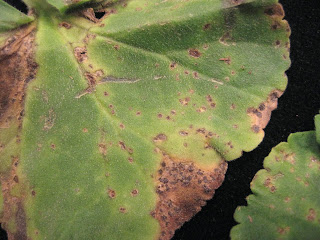 |
| Typical leaf symptoms of bacterial blight of geranium. |
 |
| Close-up of upper leaf surface of Xanthomonas-infected geranium. |
When Xanthomonas blight is confirmed in a geranium crop, the affected plants must be discarded, including the potting mix. Workers should avoid working among healthy geraniums after handling diseased plants. Asymptomatic (apparently healthy) plants next to diseased plants should also be destroyed, since they likely have populations of the bacterium on or in their tissues. The same goes for geraniums grown under hanging baskets containing diseased geraniums. All surfaces that had been in contact with these plants should be cleaned and then sanitized. This includes benches, tools, and pots. There’s a table with detailed information about sanitizers in the "Nursery Crops" section of the Plant Pathology Department Ornamentals page.
Preventive applications of a copper-based fungicide/bactericide, rotated with the biological control Bacillus subtilis, may reduce the spread of bacterial blight, but is not an effective strategy on its own. Use of clean stock and rigorous sanitation are the essential steps. For details on chemical applications, see p.448 of Table 10-11 in the 2015 North Carolina Agricultural Chemicals Manual.
For more information, see the following publications:
Bacterial Blight of Geranium by Gary Moorman of the Pennsylvania State University
Bacterial Blight of Geranium by M.B. Dicklow of the University of Massachusetts
A special thank-you to Dr. Mike Benson for reviewing this post.
